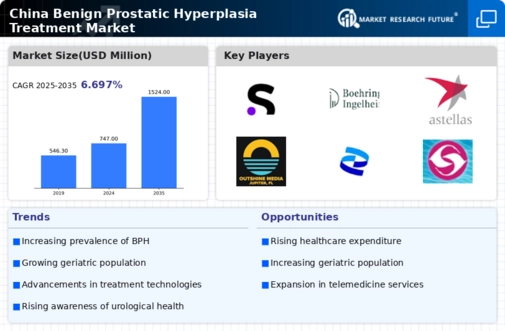Increased Awareness and Education
There is a growing awareness regarding benign prostatic hyperplasia among the male population in China, which is significantly impacting the benign prostatic-hyperplasia-treatment market. Educational campaigns and outreach programs by healthcare providers are informing men about the symptoms and treatment options available. This increased awareness is leading to more men seeking medical advice and treatment, thereby expanding the patient pool. Reports indicate that early diagnosis and treatment can lead to better health outcomes, which further encourages men to address their symptoms proactively. Consequently, the benign prostatic-hyperplasia-treatment market is experiencing growth as more individuals recognize the importance of managing their health.
Rising Incidence of Comorbidities
The rising incidence of comorbidities such as diabetes and cardiovascular diseases among the male population in China is contributing to the growth of the benign prostatic-hyperplasia-treatment market. These conditions often exacerbate urinary symptoms associated with BPH, prompting patients to seek treatment. Studies indicate that men with diabetes are at a higher risk of developing BPH, which may lead to increased healthcare utilization. As healthcare providers address these comorbidities, the benign prostatic-hyperplasia-treatment market is likely to see a surge in demand for integrated treatment approaches that consider the overall health of patients. This trend may drive innovation and the development of comprehensive treatment plans.
Advancements in Treatment Technologies
Technological advancements in the benign prostatic-hyperplasia-treatment market are reshaping the landscape of treatment options available in China. Innovations such as laser therapy, minimally invasive surgical techniques, and new pharmacological agents are enhancing treatment efficacy and patient outcomes. For instance, the introduction of new medications has shown to improve urinary symptoms in up to 70% of patients. These advancements not only improve the quality of life for patients but also reduce recovery times and hospital stays, making treatments more appealing. As these technologies continue to evolve, the benign prostatic-hyperplasia-treatment market is likely to expand, driven by the demand for more effective and less invasive treatment solutions.
Aging Population and Increased Incidence
The aging population in China is a primary driver for the benign prostatic-hyperplasia-treatment market. As men age, the likelihood of developing benign prostatic hyperplasia (BPH) increases significantly. Current estimates suggest that approximately 50% of men aged 50 and older experience some degree of BPH. This demographic trend indicates a growing patient base requiring treatment options. Furthermore, the prevalence of BPH is projected to rise, leading to an increased demand for various treatment modalities, including medication and surgical interventions. The benign prostatic-hyperplasia-treatment market is thus poised for growth as healthcare providers adapt to the needs of an aging population, ensuring that effective treatment options are accessible.
Government Initiatives and Healthcare Policies
Government initiatives aimed at improving healthcare access and affordability are influencing the benign prostatic-hyperplasia-treatment market in China. Policies that promote early diagnosis and treatment of BPH are being implemented, which may include subsidizing medications and treatments. Such initiatives are likely to enhance patient access to necessary care, thereby increasing the number of individuals seeking treatment. Additionally, the government is focusing on expanding healthcare infrastructure, which could facilitate better service delivery in the benign prostatic-hyperplasia-treatment market. As these policies take effect, they may lead to a more robust market environment, encouraging further investment in treatment options.



















Leave a Comment